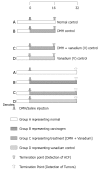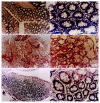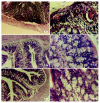Effect of vanadium on colonic aberrant crypt foci induced in rats by 1,2 dimethyl hydrazine
- PMID: 12717849
- PMCID: PMC4611365
- DOI: 10.3748/wjg.v9.i5.1020
Effect of vanadium on colonic aberrant crypt foci induced in rats by 1,2 dimethyl hydrazine
Abstract
Aim: To investigate the chemo preventive effects of vanadium on rat colorectal carcinogenesis induced by 1,2-dimethylhydrazine (DMH).
Methods: Male Sprague-Dawley Rats were randomly divided into four groups. Rats in Group A received saline vehicle alone for 16 weeks. Rats in Group B were given DMH injection once a week intraperitoneally for 16 weeks; rats in Group C, with the same DMH treatment as in the Group B, but received 0.5-ppm vanadium in the form ammonium monovanadate ad libitum in drinking water. Rats in the Group D received vanadium alone as in the Group C without DMH injection.
Results: Aberrant crypt foci (ACF) were formed in animals in DMH-treated groups at the end of week 16. Compared to DMH group, vanadium treated group had less ACF (P<0.001). At the end of week 32, all rats in DMH group developed large intestinal tumors. Rats treated with vanadium contained significantly few colonic adenomas and carcinomas (P<0.05) compared to rats administered DMH only. In addition, a significant reduction (P<0.05) in colon tumor burden (sum of tumor sizes per animal) was also evident in animals of Group C when compared to those in rats of carcinogen control Group B. The results also showed that vanadium significantly lowered PCNA index in ACF (P<0.005). Furthermore, vanadium supplementation also elevated liver GST and Cyt P-450 activities (P<0.001 and P<0.02, respectively).
Conclusion: Vanadium in the form of ammonium monovanadate supplemented in drinking water ad libitum has been found to be highly effective in reducing tumor incidence and preneoplastic foci on DMH-induced colorectal carcinogenesis. These findings suggest that vanadium administration can suppress colon carcinogenesis in rats.
Figures




Similar articles
-
Vanadium inhibits placental glutathione S-transferase (GST-P) positive foci in 1,2-dimethyl hydrazine induced rat colon carcinogenesis.J Biochem Mol Toxicol. 2003;17(6):357-65. doi: 10.1002/jbt.10099. J Biochem Mol Toxicol. 2003. PMID: 14708091
-
Vanadium inhibits DNA-protein cross-links and ameliorates surface level changes of aberrant crypt foci during 1,2-dimethylhydrazine induced rat colon carcinogenesis.Cell Biol Toxicol. 2005 Jan;21(1):41-52. doi: 10.1007/s10565-005-1782-x. Cell Biol Toxicol. 2005. PMID: 15868487
-
Chemopreventive potential of zinc in experimentally induced colon carcinogenesis.Toxicol Lett. 2007 Jun 15;171(1-2):10-8. doi: 10.1016/j.toxlet.2007.02.002. Epub 2007 Feb 20. Toxicol Lett. 2007. PMID: 17590543
-
Morphological and molecular alterations in 1,2 dimethylhydrazine and azoxymethane induced colon carcinogenesis in rats.J Biomed Biotechnol. 2011;2011:473964. doi: 10.1155/2011/473964. Epub 2010 Dec 28. J Biomed Biotechnol. 2011. PMID: 21253581 Free PMC article. Review.
-
Allyl sulfur compounds from garlic modulate aberrant crypt formation.J Nutr. 2006 Mar;136(3 Suppl):852S-854S. doi: 10.1093/jn/136.3.852S. J Nutr. 2006. PMID: 16484579 Review.
Cited by
-
Aberrant crypt foci and AgNORs as putative biomarkers to evaluate the chemopreventive efficacy of pronyl-lysine in rat colon carcinogenesis.Invest New Drugs. 2008 Dec;26(6):531-40. doi: 10.1007/s10637-008-9122-7. Epub 2008 Feb 29. Invest New Drugs. 2008. PMID: 18309460
-
Sodium orthovanadate inhibits growth and triggers apoptosis of human anaplastic thyroid carcinoma cells in vitro and in vivo.Oncol Lett. 2019 May;17(5):4255-4262. doi: 10.3892/ol.2019.10090. Epub 2019 Feb 28. Oncol Lett. 2019. PMID: 30944619 Free PMC article.
-
Chemopreventive Activity of 80% Methanol Leaf Extract of Vernonia auriculifera Hiern (Asteraceae) Against Dimethylhydrazine-Induced Colorectal Carcinogenesis in Rats.J Exp Pharmacol. 2023 Sep 4;15:333-347. doi: 10.2147/JEP.S421338. eCollection 2023. J Exp Pharmacol. 2023. PMID: 37691740 Free PMC article.
References
-
- Potter JD, McMichael AJ. Diet and cancer of the colon and rectum: a case-control study. J Natl Cancer Inst. 1986;76:557–569. - PubMed
-
- Mukhtar H, Athar M. Dietary anticarcinogens and cancer prevention. Cleve Clin J Med. 1988;55:507–508. - PubMed
-
- Pitot HC. Fundamentals of Oncology. New York: Marcel Dekker, Inc. 1986
-
- Pozharisski KM, Likhachev AJ, Klimashevski VF, Shaposhnikov JD. Experimental intestinal cancer research with special reference to human pathology. Adv Cancer Res. 1979;30:165–237. - PubMed
Publication types
MeSH terms
Substances
LinkOut - more resources
Full Text Sources
Research Materials
Miscellaneous

